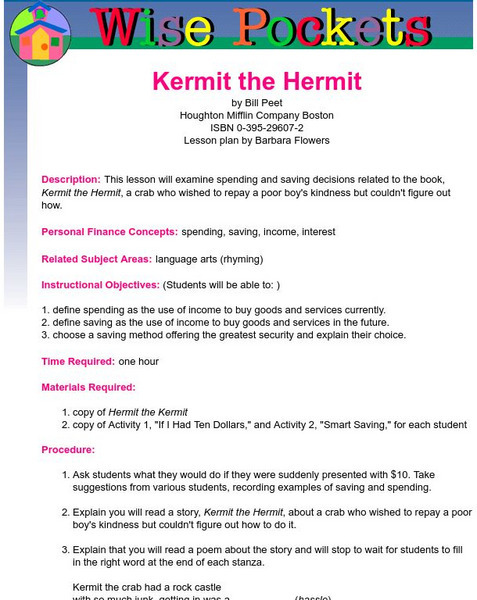Practical Money Skills
Practical Money Skills: Lesson One: Making Spending Decisions
The goal of this instructional activity is to introduce structured spending decisions to assist young children in making choices and to recognize that money comes in limited amounts.
Khan Academy
Khan Academy: Lesson Summary: Definition, Measurement, and Functions of Money
This information is intended for AP Macroeconomics students or for those taking college macroeconomics. This lesson plan reviews key terms and calculations related to the definition, measurement, and functions of money. Topics include...
Teachnology
Teachnology: Math Lesson Plans
Great lesson plans covering a wide-range of math-related subjects.
Smithsonian Institution
Smithsonian Learning Lab: What Shape Is Money? Money Doesn't Have to Be Round or Rectangular
Pigs, rice, nuts, teeth, eggs, feathers - these are all types of currency! This lesson plan discusses different types of objects that can be used as currency and students will decide what qualities make an effective currency. Included...
Council for Economic Education
Econ Ed Link: Do I Look Like I'm Made of Money?
One of the most common replies given by parents when their children ask for money is "Do I look like I'm made of Money?" This lesson is designed to educate students about the need for money as a generally accepted medium of exchange. The...
Better Lesson
Better Lesson: Time and Money
As the result of a Unit assessment, it was found that students showed some confusion with writing time and with adding sets of coins. These skills need to be reviewed to aid in mastery of the Common Core standards for time and money.
Practical Money Skills
Practical Money Skills for Life: Lesson Plans
A series of financial literacy lesson plans broken out by grade range for grades from Pre-K through college, with an additional set of lessons created for students with special needs.
AAA Math
Aaa Math: Aaa Math Lessons
AAA Math's interactive tutorials and lessons assist students grades K-8 improve their understanding of a wide range of arithmetic topics. Students are provided with immediate feedback as they complete the "Learn," "Practice," and "Play"...
Scholastic
Scholastic: Adventures in Math: Lesson 3: Money in Our Community
Lesson focuses on how and why money circulated within our community. Being able to discern the difference between things we need and things we want is one of the foundational concepts for using money wisely. Goods and services are things...
Scholastic
Scholastic: Adventures in Math: Lesson 1: Money Matters
The process of earning money is the cornerstone of financial literacy. In this lesson, students will identify key terms associated with earning money, explore ideas for earning money now, and evaluate various career options as sources of...
University of Missouri
University of Missouri: Wise Pockets: Four Dollars and Fifty Cents
This is a instructional activity geared towards elementary level students. Using the book Four Dollars and Fifty Cents by Eric Kimmel, the teacher instructs students about the terms creditor, debtor, collateral, credit, and credit...
Better Lesson
Better Lesson: Hundreds, Tens, Ones Are Coins Too
Second graders will extend their understanding of hundreds, tens and ones using dollars, dimes and pennies as another way to express groups of 100, 10 and 1.
TED Talks
Ted: Ted Ed: The Time Value of Money
We've all heard the phrase "Time is money." But what do these two things actually have to do with one another? German Nande explains the math behind interest rates, revealing the equation that will allow you to calculate the future value...
Better Lesson
Better Lesson: Unit 3 Assessment
It is important to assess students periodically to plan for future lessons to meet student needs.
Scholastic
Scholastic: Adventures in Math: Lesson 1: Saving Money for Your Future
Tips for learning the value of saving money to achieve your financial goals.
Better Lesson
Better Lesson: Cheerful Shoppers
Second graders love to shop! Students will use their own shopping list to compose a word problem using addition and subtraction with and without regrouping, in order to help them better understand how to problem solve.
Council for Economic Education
Econ Ed Link: Where Did All the Money Go? The Great Depression Mystery
Use this lesson plan to have students investigate how the American economy went from boom to bust in the 1920s. Find the resources needed for the lesson plan as well as important discussion questions for individual and class consideration.
Other
Finra Investor Education Foundation: Introduction to Earning Interest 11 & 12
Students will know and be able to use the formula for calculating compound interest and understand the effect of compounding on savings in this instructional activity.
University of Missouri
University of Missouri St. Louis:wise Pockets: Kermit the Hermit
This is an elementary level lesson that deals with spending, saving, income, and interest. Requires the book Kermit the Hermit by Bill Peet. Includes detailed lesson plan along with procedures and activities.
Federal Reserve Bank
Federal Reserve Bank of Philadelphia: Why Money? [Pdf]
Middle schoolers learn about barter, and the benefits of using money, as they participate in this trading simulation.
Other
Money Management International: The Berenstain Bears' Trouble With Money
A lesson plan featuring the Berenstain Bears that introduces the concepts of spending, goods, services, income, saving, and interest.
PBS
Pbs: The Fall of the Dollar (Lesson Plan)
A instructional activity that helps student understand how exchange rates are determined and how the value of a nation's currency is connected to its international trade. Young scholars use an article from a time when the U.S. dollar was...
Federal Reserve Bank
Federal Reserve Bank of Philadelphia: What Is the Federal Reserve? [Pdf]
Questions like "How does the bank hold reserves?" or "How do banks make deposits?" are examples of what is explained through this banking simulation lesson plan to illustrate the purpose of the Federal Reserve.
Writing Fix
Writing Fix: Smart Math and Writing
In this lesson plan, the poem "Smart" from Where the Sidewalk Ends, by Shel Silverstein, is used as the mentor text. Young scholars will write a map of the poem and then analyze it to discover what happened when trades with money were...
Other popular searches
- Money Lessons Giving Change
- Counting Money Lessons
- Canadian Money Lessons
- Second Grade Money Lessons
- 2nd Grade Money Lessons
- Australian Money Lessons
- Shopping Money Lessons
- Math Money Lessons
- Money Lessons Elementary
- Fun Money Lessons
- Counting Money Math Lessons
- Adding Money Amounts Lessons













![Federal Reserve Bank of Philadelphia: Why Money? [Pdf] Lesson Plan Federal Reserve Bank of Philadelphia: Why Money? [Pdf] Lesson Plan](http://content.lessonplanet.com/resources/thumbnails/409976/large/bwluav9tywdpy2symdiwmduymc0xmdm5ny0xdnbua3j3lmpwzw.jpg?1589982798)


![Federal Reserve Bank of Philadelphia: What Is the Federal Reserve? [Pdf] Lesson Plan Federal Reserve Bank of Philadelphia: What Is the Federal Reserve? [Pdf] Lesson Plan](http://content.lessonplanet.com/resources/thumbnails/409975/large/bwluav9tywdpy2symdiwmduymc0xmdqxmc03zmj5zmguanbn.jpg?1589982798)
